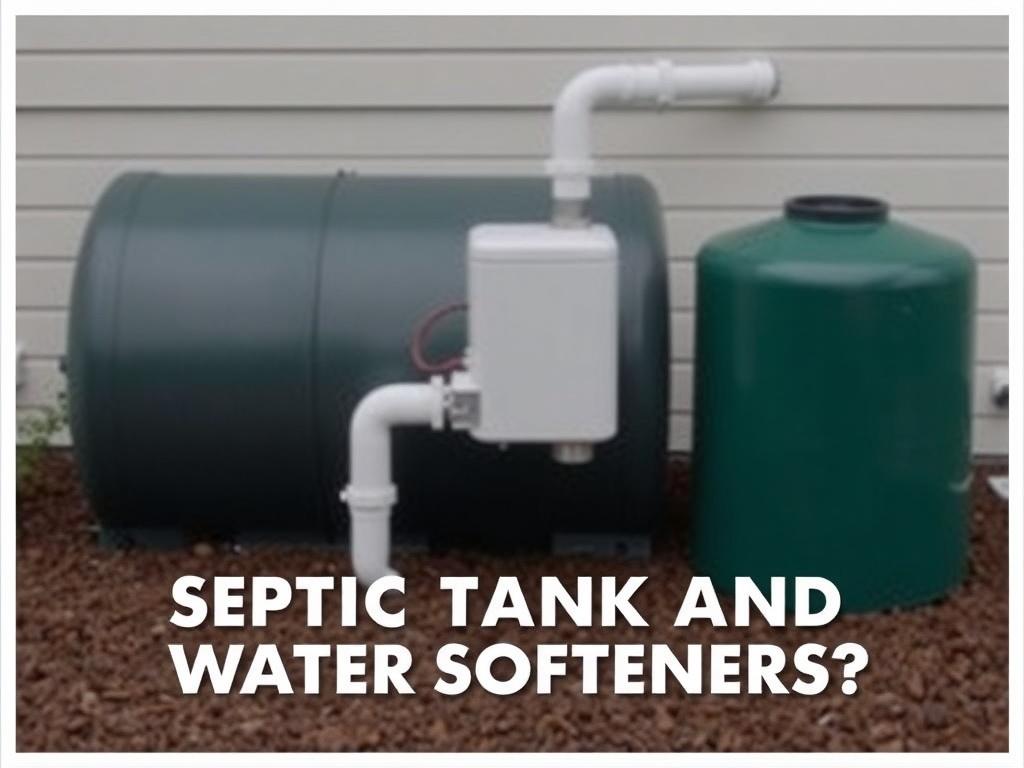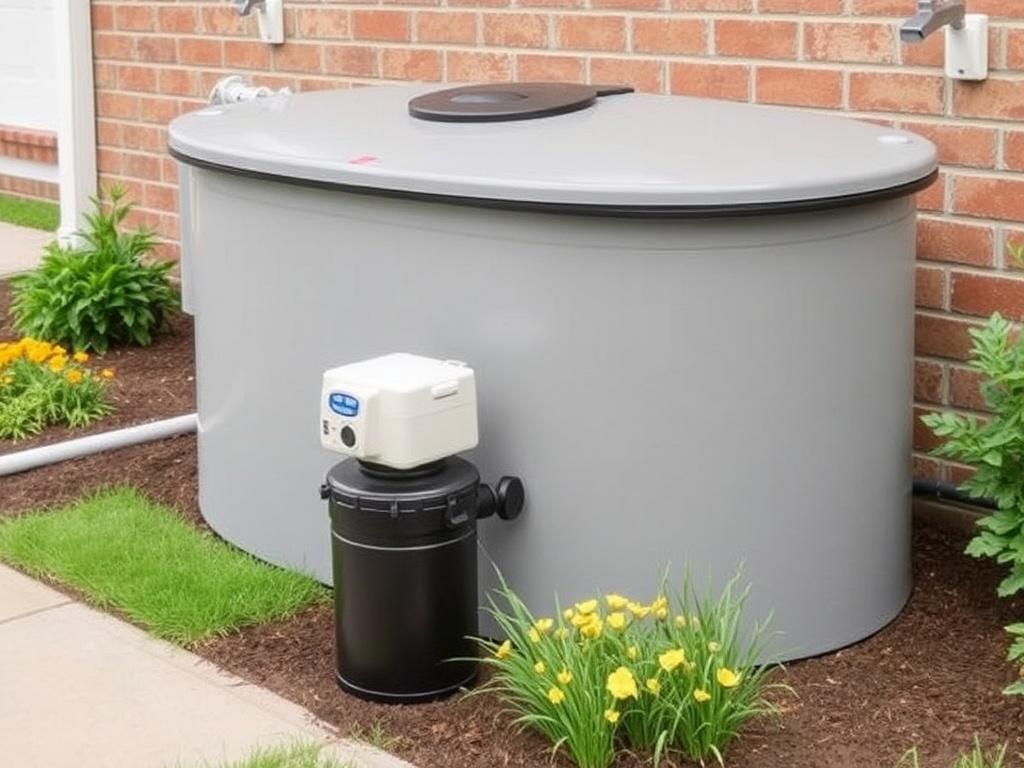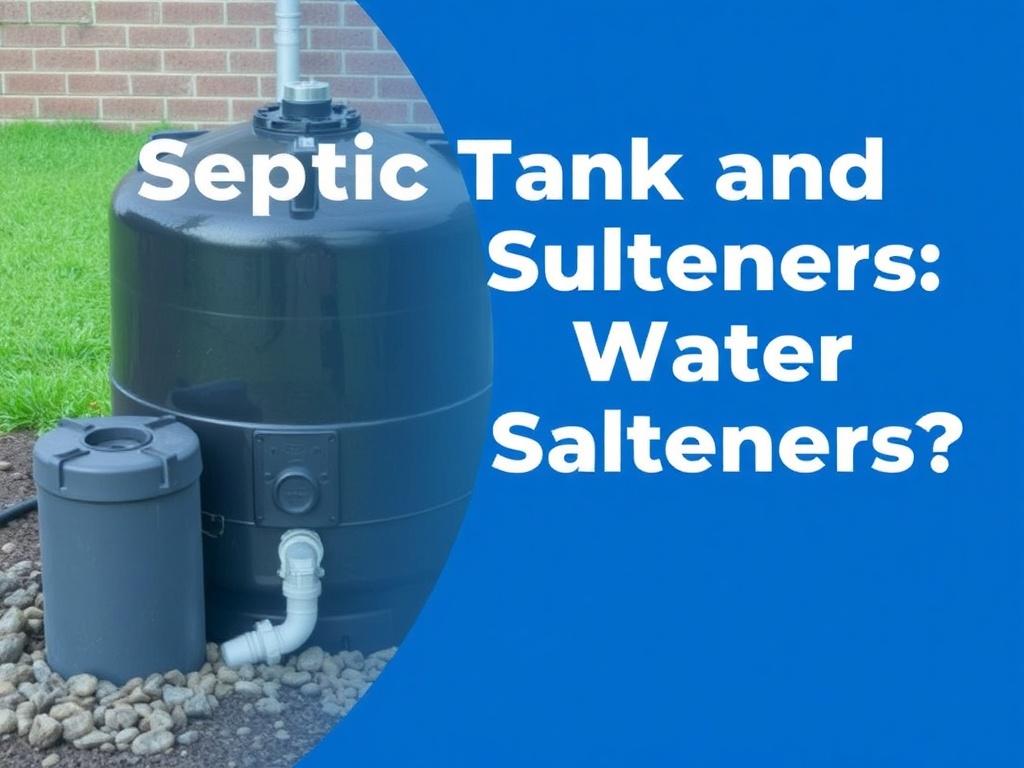When it comes to managing household water systems, two topics often come into focus: septic tanks and water softeners. They both play important roles in how water is handled and treated in homes, but many homeowners wonder if using a water softener can cause issues with a septic tank. If you’re trying to understand septic tank and water softener compatibility, you’ve come to the right place. This article will explore everything you need to know about septic tanks and water softeners, how they interact, potential issues, and best practices to ensure both systems work efficiently together.
- Understanding Septic Tanks: What Are They and How Do They Work?
- Water Softeners Explained: What Do They Do?
- Potential Concerns: Septic Tank and Water Softener Interactions
- Effect of Salt on Septic Bacteria
- Impact on Drain Field
- Addressing the Issues: How to Minimize Risks
- 1. Proper Water Softener Sizing
- 2. Limit Regeneration Frequency
- 3. Use Potassium Chloride Instead of Sodium Chloride
- 4. Maintain Your Septic System
- 5. Water Conservation
- 6. Consider Alternative Water Treatment Systems
- Signs Your Septic Tank Might Be Affected by a Water Softener
- Comparing Water Softener Salt Types and Their Effects
- How to Test Your Septic System Water Softener Compatibility
- Common Myths and Misconceptions About Septic Tanks and Water Softeners
- Tips for Maintaining a Healthy Septic System When Using a Water Softener
- Environmental Impact: What About Salt in the Groundwater?
- Summary Table: Pros and Cons of Using a Water Softener with a Septic Tank
- How to Choose the Right Water Softener for a Home with a Septic System
- Final Thoughts on Septic Tanks and Water Softeners
- Conclusion
Understanding Septic Tanks: What Are They and How Do They Work?
Before getting into any potential problems between septic tanks and water softeners, it’s important to understand what septic tanks are and how they function. A septic tank is a key component of an onsite wastewater treatment system commonly found in rural areas or places without centralized sewer systems. The tank itself is a large underground container designed to collect and treat household wastewater.
Septic tanks work by allowing solids to settle at the bottom, creating a sludge layer, while oils and grease float to the top forming a scum layer. Between these layers is relatively clear water, which slowly leaves the tank and enters a drain field for further natural filtration into the soil. This process depends heavily on bacteria breaking down the solids and organic matter within the tank.
Because septic tanks rely on a delicate balance of bacteria to digest waste, anything that harms these microorganisms can disrupt the system’s performance. Therefore, being mindful of what goes into the septic tank is essential for its longevity and efficiency.
Water Softeners Explained: What Do They Do?
Water softeners are household devices designed to treat hard water. Hard water contains high levels of minerals like calcium and magnesium, which can leave deposits in pipes and appliances, reduce soap effectiveness, and cause other problems. A water softener removes those minerals through a process called ion exchange, where calcium and magnesium ions are swapped for sodium or potassium ions.
Most water softeners have a resin tank filled with beads that attract hard mineral ions. As hard water passes through, these minerals are trapped, and soft water exits for use in the home. Periodically, the system flushes the resin beads with a salt brine solution to recharge them, releasing the trapped minerals into the wastewater.
This regeneration process produces a salty discharge, commonly called brine, which flows into the household wastewater system and eventually into the septic tank or municipal sewer line.
Potential Concerns: Septic Tank and Water Softener Interactions

One of the most common questions homeowners ask is whether the salty brine produced by water softeners can cause problems with septic tanks. The primary concerns revolve around the effects of salty water on the bacteria in the septic tank and the potential for salt to negatively impact the soil in the drain field.
Effect of Salt on Septic Bacteria
The beneficial bacteria in septic tanks perform the essential task of breaking down waste solids. Because the water softener’s regeneration process discharges sodium or potassium chloride salts, there is a legitimate worry that these salts may harm or kill those bacteria.
Research and expert opinions vary, but many studies suggest that while high levels of salt can temporarily inhibit bacterial activity, typical usage amounts of water softener brine do not cause long-term harm to septic bacteria. Septic systems are often resilient enough to recover from intermittent salt discharges.
However, if a household uses a very large water softener or regenerates it too frequently, the accumulation of salt in the septic tank can become problematic. In those cases, the salt concentration might reach levels that significantly reduce bacterial populations, disturbing the decomposition process and leading to septic system failures.
Impact on Drain Field
Another aspect to consider is the impact of salt on the soil where septic tank effluent is released. The drain field relies on soil permeability to filter water before it returns to the groundwater. Excessive salt can alter soil structure and reduce its ability to absorb and treat effluent water. Depending on the soil type, salt might lead to clogging or degradation of the soil’s filtering system.
Homes with sandy or highly permeable soil tend to have fewer issues because the salt dilutes and disperses more easily. On the other hand, clay or compacted soils are more susceptible to negative effects from salt accumulation.
Addressing the Issues: How to Minimize Risks
Now that we have an idea of what kinds of potential issues can arise when using a water softener with a septic tank, let’s discuss practical ways to minimize these risks and maintain a healthy septic system.
1. Proper Water Softener Sizing
Choosing the right size water softener for your household is crucial. A system that’s too large will regenerate more salt than needed, resulting in excess brine entering your septic system. Discuss your household’s water hardness and water usage with a reputable water softener dealer to ensure you don’t use more salt than necessary.
2. Limit Regeneration Frequency
Try to avoid frequent regenerations. Many modern water softeners come with demand-initiated regeneration technology, meaning the system only regenerates when necessary based on water usage, reducing salt discharge and water consumption.
3. Use Potassium Chloride Instead of Sodium Chloride
Most water softeners use sodium chloride salts; however, potassium chloride is an alternative that is less harmful to septic bacteria and soil health. Although potassium chloride tends to be more expensive, it could be a worthwhile investment for protecting your septic system.
4. Maintain Your Septic System
Regular septic tank inspections and pumping are vital to keep your system operating efficiently. By removing accumulated sludge and maintaining healthy bacteria populations, you mitigate potential effects coming from softener brine.
5. Water Conservation
Reducing overall water usage decreases the volume of softener brine entering your septic system, making it easier for the bacteria to handle the salt load. Simple conservation measures such as fixing leaks, installing low-flow fixtures, and mindful water use can have a positive impact.
6. Consider Alternative Water Treatment Systems
If you suspect compatibility issues or already have a compromised septic system, explore alternative water treatment options like electronic or magnetic descalers that reduce hardness without salt or brine discharge.
Signs Your Septic Tank Might Be Affected by a Water Softener
It’s wise to be aware of warning signs that your septic system might be struggling due to softener brine or other factors. Watch out for the following:
- Slow draining sinks, showers, or toilets.
- Unpleasant odors near your septic tank or drain field.
- Pooling water or soggy areas above the drain field.
- Septic system backups inside the home.
- Increased frequency of septic tank pumping.
If these symptoms occur, it could indicate bacterial imbalances or soil problems related to salt accumulation.
Comparing Water Softener Salt Types and Their Effects
| Salt Type | Common Use | Effect on Septic System | Cost Considerations |
|---|---|---|---|
| Sodium Chloride | Most common; table salt or rock salt | Can inhibit septic bacteria but usually manageable in typical doses | Generally inexpensive |
| Potassium Chloride | Alternative salt option | Less harmful to septic bacteria and soil health | More expensive than sodium chloride |
| Solar Salt | High purity sodium chloride | Similar effects as regular sodium chloride | Moderate cost |
| Evaporated Salt Pellets | Highly pure sodium chloride pellets | May reduce sediment buildup in softener | Higher cost; improves softener efficiency |
How to Test Your Septic System Water Softener Compatibility
If you are still unsure about whether your water softener is affecting your septic system, there are steps you can take:
- Monitor Effluent Quality: Have a professional test the septic effluent for salt concentration and bacteria levels.
- Inspect Soil Percolation: Conduct soil tests to evaluate drain field permeability and assess salt buildup risks.
- Check Water Softener Settings: Confirm that your softener is operating efficiently without excessive regeneration cycles.
- Consult Local Experts: Your local health department or septic professionals may offer guidance tailored to your area’s soil and water conditions.
Common Myths and Misconceptions About Septic Tanks and Water Softeners

Like many home maintenance topics, septic tanks and water softeners are surrounded by myths that can cause unwarranted concern or neglect. Let’s clear up a few common misconceptions:
- Myth: Water softeners will always ruin a septic tank.
Fact: Properly used water softeners typically do not cause septic tank failure if maintained correctly. - Myth: You must never use a water softener if you have a septic system.
Fact: Many homeowners safely use water softeners with septic tanks by following best practices. - Myth: Sodium from water softeners makes your drinking water unsafe.
Fact: The sodium increase from softened water is minimal and generally safe for healthy individuals. - Myth: Homeowners must switch to potassium chloride to protect septic tanks.
Fact: While potassium chloride is gentler on septic systems, many systems tolerate sodium chloride at normal levels.
Tips for Maintaining a Healthy Septic System When Using a Water Softener
To ensure your septic tank does not suffer from water softener use, apply these helpful tips:
- Schedule septic inspections every 3 to 5 years, or more frequently with heavy salt use.
- Use high-efficiency water softeners that minimize salt usage.
- Space out water softener regenerations instead of running frequent cycles.
- Consider water treatment options that reduce salt reliance, such as template-assisted crystallization.
- Keep records of your water softener salt usage and septic system maintenance.
- Fix leaks and reduce water waste to lower the load on both systems.
Environmental Impact: What About Salt in the Groundwater?
Besides septic tank health, the salt discharged from water softeners can have broader environmental implications. Brine from water softeners eventually percolates through the soil, potentially reaching groundwater supplies. High salt concentrations in groundwater can affect plant life, aquatic ecosystems, and even drinking water sources.
Municipal authorities in some areas have started regulating or restricting water softener use to protect sensitive environments. If you live in such a region, it is essential to adhere to local guidelines or consider salt-free water conditioning alternatives.
Summary Table: Pros and Cons of Using a Water Softener with a Septic Tank
| Pros | Cons |
|---|---|
| Improves household water quality by reducing scale and hard minerals | Salt discharge can negatively impact septic bacteria if overused |
| Extends lifespan of plumbing and appliances | Potential for salt buildup in drain field soil, affecting filtration |
| Modern softeners can minimize salt usage with demand regeneration | Excessive freshwater usage during regeneration adds to septic system load |
| Possible to choose potassium chloride to reduce environmental impact | Additional maintenance required to protect septic system |
How to Choose the Right Water Softener for a Home with a Septic System
When shopping for a water softener, keep in mind these factors relevant to septic tank compatibility:
- Salt Efficiency: Look for models with high salt efficiency ratings to minimize brine discharge.
- Demand-Initiated Regeneration: Softener that regenerates based on actual water use reduces unnecessary salt usage.
- Salt Type Compatibility: Check for options compatible with potassium chloride if you prefer a gentler salt alternative.
- Size Appropriateness: Avoid oversizing your softener; match capacity to household needs.
- Maintenance Requirements: Choose systems easy to clean and maintain to ensure peak performance.
Final Thoughts on Septic Tanks and Water Softeners

Many homeowners face the dilemma of improving water quality through softening while preserving the health of their septic systems. Understanding how septic tanks work and how water softener brine interacts with them is key to making informed decisions. While there are genuine concerns about salt’s effects on septic bacteria and drain fields, following best practices such as proper sizing, reduced regeneration frequency, and regular septic maintenance can significantly reduce any negative impact. Alternative salt types and new water treatment technologies offer additional options for environmentally conscious homeowners. Ultimately, with mindful usage and care, water softeners and septic tanks can coexist harmoniously, ensuring you enjoy soft water without compromising your septic system’s functionality or the surrounding environment.
Conclusion
Navigating the relationship between your septic tank and water softener doesn’t have to be complicated. By understanding how both systems work and what challenges salt discharge might present, you can take proactive steps to protect your septic system while enjoying the benefits of softened water. From choosing the right type of salt to maintaining your septic tank through regular inspections and pumping, small efforts can go a long way. If in doubt, consulting with septic professionals or water treatment experts will help tailor solutions to your specific household needs and local conditions. Remember, balance and moderation are key—used wisely, water softeners enhance your water quality without causing harm to your septic system, keeping both systems running smoothly for years to come.
Помогла вам статья?






